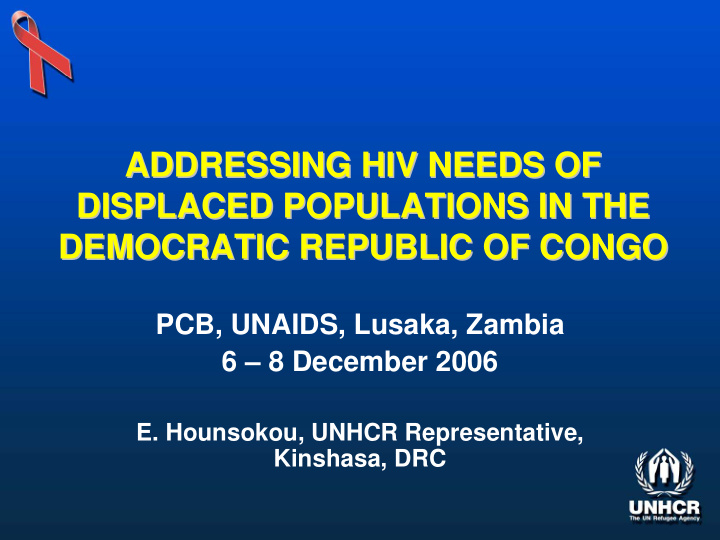



ADDRESSING HIV NEEDS OF ADDRESSING HIV NEEDS OF DISPLACED POPULATIONS IN THE DISPLACED POPULATIONS IN THE DEMOCRATIC REPUBLIC OF CONGO DEMOCRATIC REPUBLIC OF CONGO PCB, UNAIDS, Lusaka, Zambia 6 – 8 December 2006 E. Hounsokou, UNHCR Representative, Kinshasa, DRC
Role of UNHCR Role of UNHCR • 1951 Refugee Convention : ‘State parties shall accord to refugees in their territories access to the same ‘public relief and assistance as their nationals, including medical care.’ • Became UNAIDS cosponsor in June 2004 • Lead organisation for HIV and displaced persons (IDPs and refugees) acc. to UNAIDS div. of labour – Complimentary to HCR’s lead role in Protection, Shelter and Camp Mgt within humanit. reform process
Displacement Cycle Displacement Cycle Border Conflict- affected population Return Refugees Repatriation Host IDPs community Host Interactions with other linked populations: community -Armed forces/peacekeepers -Sex workers
Refugee and Internally Refugee and Internally Displaced Persons (IDPs) in DRC Displaced Persons (IDPs) in DRC • UNHCR provides assistance to: – Refugees 224,000 – Returnees 82,000 – IDPs 1.6 million • IDPs often worse off than refugees who enjoy protection under 1951 Convention
Impact of Conflict and Impact of Conflict and displacement displacement • Pre-existing poverty exacerbated • Community social structures broken and ability to cope compromised • Often struggle for survival • Women and children most vulnerable incl. sexual gender-based violence (SGBV) – In DRC, wide scale rape • Rape survivors stigmatised and shunned by partners and communities • Drugs and alcohol abuse common
IDPs Fleeing Conflict in IDPs Fleeing Conflict in Central Katanga Central Katanga
Return and Reintegration Return and Reintegration Programs Programs • UNHCR in DRC is implementing the following: • Medical screening. • HIV/AIDS awareness campaigns • Condom distribution • Provision of counselling services to returnees • In some instances, PLWAs advised to delay return until ART available in areas of origin • Every returnee educated about HIV through mass information activities in host country and/or on arrival in country of origin
Collaboration Collaboration • UNHCR collaborates with UNAIDS Country Coordinator and team, cosponsors, Gov, int’l and nat’l NGOs and donors • Various for HIV interventions for displaced persons are mapped out w aim of strengthening nat’l and regional initiatives – Integrated approach w host comm. – e.g. World Bank funded GLIA project and World Bank MAP for DRC
Challenges Challenges • Sustained stability in DRC: – Critical for return and reintegration – National plans can take hold in more comprehensive fashion – Basic support infrastructure can be put into place – Requires increased resources • HIV is cross-cutting issue that requires improved coordination, advocacy, and resources with active involvement of Gov, donors, UN agencies, NGOs and beneficiaries • Flexible funding to change acc. to IDP/ref sit’ns • Gathering reliable data at nat’l and regional level
Recommend
More recommend